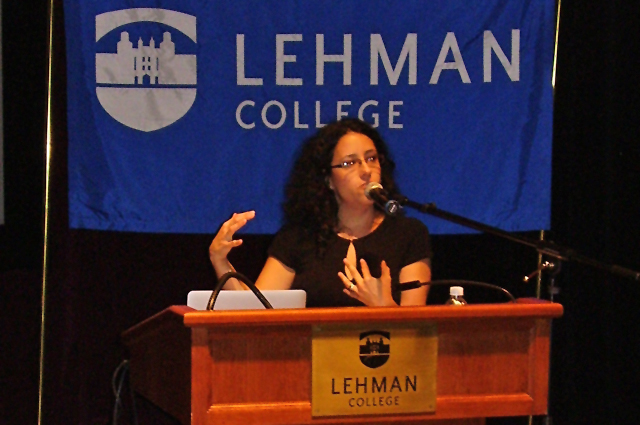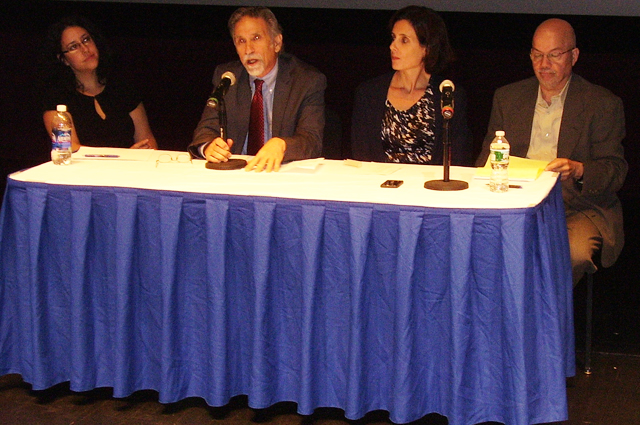Dr. Teresita Levy
By Lennin Reyes
Bronx Journal Staff Reporter
Current presidential candidates could learn a thing or two from Puerto Ricans politics. Voter turnout in the territory is exceptionally high, with about 90 percent of voters heading to the polls each election.
In Puerto Rico, Puerto Ricans can vote in local elections and presidential primaries, but they cannot vote in general presidential elections. This may soon change with an upcoming plebiscite, a referendum on Puerto Rico’s status.
If Puerto Ricans vote for statehood, they would have the right to vote and attain Congressional representation in the U.S., which could affect the way future presidential candidates campaign.
This was the topic of “La Ola Latina,” an event held at Lovinger Theatre on October 15, with attendees suggesting that politicians look to the island to see how it generates such enthusiasm among voters. “Politics is a bloodsport,” Lehman president Dr. Ricardo Fernández said. “As a kid, I remember seeing brooms in car tires because people would throw tacks at them to prevent them from reaching the polls.”
Held at the tail end of Hispanic Heritage Month, La Ola Latina highlighted how Puerto Rico’s situation will impact future election campaigns for candidates on the island and stateside. The upcoming plebiscite ties in with the upcoming gubernatorial election, as each political party also represents a specific option to Puerto Rico’s status.
For example, incumbent governor Luis Fortuno’s New Progressive Party (PNP) favors statehood for the island. While the incumbent and his party may have a specific stance on the plebiscite, that might not match up in the polls, keynote speaker and Lehman professor Teresita Levy said. “Fortuno might win [the election], but his status [on statehood] may lose [in the plebiscite].”
The plebiscite could also be a vote against a particular candidate, something Dr. Levy said happened in the past. “In the last plebiscite [in 1998], the none-of-the-above option won with 50 percent of the vote,” Dr. Levy said. “It was a protest vote against then-incumbent governor Pedro Rossello.”
Dr. Levy also reminded attendees that while people may vote on Puerto Rico’s status, one important group in U.S. government ultimately decides the nation’s fate. “According to the Jones-Shafroth Act [the 1917 act which made Puerto Ricans U.S. citizens], Congress has the authority to change the relationship between the U.S. and Puerto Rico,” she said.
Candidates in the U.S. presidential elections have being campaigning with Puerto Ricans. While former Puerto Rican governors Carlos Romero-Barcelo and Rafael Hernandez-Colon supported the President in Kissimmee, Florida — located near the Interstate 4 corridor, a growing Latino region in the heart of a heavily-contested swing state — his Republican counterpart Mitt Romney allied with incumbent governor Fortuno.
While voter turnout on Puerto Rico is high, Dr. Levy said Puerto Rican turnout in the U.S. is a concern. “Eighty percent of Puerto Ricans living in the U.S. do not vote in U.S. elections,” Dr. Levy said. “They promise to deal with problems on the island, but those are not issues in El Barrio, in the South Bronx, in Kissimmee, on the south side of Chicago, or in Lorain, Ohio.”
Puerto Ricans are not the only Latino group with low voter turnout, said another panelist, Professor Laird Bergad. “In 2008, 66 percent of whites voted. But only 50 percent of Latinos went to the polls.”
Bergad also emphasized the importance of the Latino vote in some of the election’s key swing states. “There are states with small percentages of Latinos [such as Ohio or Iowa],” he said. “But if at least 50 percent of them [in each state] vote, they could swing the election either way.”




